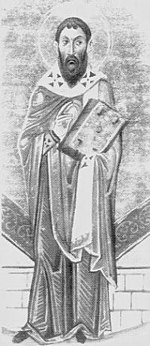- For the Bulgarian enlightener see Sophronius of Vratsa.
| St. Sophronius | |
|---|---|
| St. Sophronius of Jerusalem | |
| Patriarch of Jerusalem | |
| Born | c. 560, Damascus |
| Died | 11 March 638, Jerusalem |
| Venerated in | Roman Catholic Church, Eastern Orthodox Church |
| Feast | 11 March |
| Attributes | Vested as a bishop, with right hand upheld in blessing, holding a Gospel Book or scroll |
Sophronius (560 in Damascus – March 11, 638 in Jerusalem) (Σωφρόνιος in Greek) was the Patriarch of Jerusalem from 634 until his death, and is venerated as a saint in the Catholic Church and the Eastern Orthodox Church. Before rising to the primacy of the see of Jerusalem, he was a monk and theologian who was the chief protagonist for orthodox teaching in the doctrinal controversy on the essential nature of Jesus and his volitional acts. Bishop Sophronius was of Arab descent.[1]
A teacher of rhetoric, Sophronius became an ascetic in Egypt about 580 and then entered the monastery of St. Theodosius near Bethlehem. Traveling to monastic centres in Asia Minor, Egypt, and Rome, he accompanied the Byzantine chronicler John Moschus, who dedicated to him his celebrated tract on the religious life, Leimõn ho Leimõnon (Greek: “The Spiritual Meadow”). On the death of Moschus in Rome in 619, Sophronius accompanied the body back to Jerusalem for monastic burial. He traveled to Alexandria, Egypt, and to Constantinople in the year 633 to persuade the respective patriarchs to renounce Monothelitism, a heterodox teaching that espoused a single, divine will in Christ to the exclusion of a human capacity for choice. Sophronius' extensive writings on this question are all lost.
Although unsuccessful in this mission, Sophronius was elected patriarch of Jerusalem in 634. Soon after his enthronement he forwarded his noted synodical letter to Pope Honorius I and to the Eastern patriarchs, explaining the orthodox belief in the two natures, human and divine, of Christ, as opposed to Monothelitism, which he viewed as a subtle form of heretical Monophysitism (which posited a single [divine] nature for Christ). Moreover, he composed a Florilegium (“Anthology”) of some 600 texts from the Greek Church Fathers in favour of the orthodox tenet of Dyothelitism (positing both human and divine wills in Christ). This document also is lost.
In his Christmas sermon of 634, Sophronius was more concerned with keeping the clergy in line with the Chalcedonian view of God, giving only the most conventional of warnings of the Muslim-Arab advance on Palestine, commenting that the Arabs already controlled Bethlehem. Sophronius, who viewed the Muslim control of Palestine as "unwitting representatives of God's inevitable chastisement of weak and wavering Christians",[2] died soon after the fall of Jerusalem to the caliph Umar I in 637, but not before he had negotiated the recognition of civil and religious liberty for Christians in exchange for tribute - an agreement known as Umari Treaty. The caliph himself came to Jerusalem, and met with the patriarch at the Church of the Holy Sepulchre. Sophronius invited Umar to pray there, but Umar declined, fearing to endanger the Church's status as a Christian temple.[3]
Beside polemics, Sophronius' writings included an encomium on the Alexandrian martyrs Cyrus and John in gratitude for an extraordinary cure of his failing vision. He also wrote 23 Anacreontic (classical metre) poems on such themes as the Arab siege of Jerusalem and on various liturgical celebrations. His Anacreontica 19 and 20 seem to be an expression of the longing desire he had of the Holy City, possibly when he was absent from Jerusalem during one of his many journeys. The order of the two poems has to be inverted to establish a correct sequence of the diverse subjects. Arranged in this way, the two poems describe a complete circuit throughout the most important sanctuaries of Jerusalem at the end of 6th century, described as the golden age of Christianity in the Holy Land. Themes of Anacreonticon 20 include the gates of Jerusalem (or Solyma), the Anastasis, the Rock of the Cross, the Constantinian Basilica, Mount Sion, the Praetorium, St. Mary at the Probatica, and Gethsemane. The Mount of Olives, Bethany, and Bethlehem come next in Anacreonticon 19.
Bibliography[]
- This article incorporates text from the Encyclopædia Britannica, Eleventh Edition, a publication now in the public domain.
Further reading[]
- D. Woods, 'The 60 Martyrs of Gaza and the Martyrdom of Bishop Sophronius of Jerusalem’, ARAM Periodical 15 (2003), 129-50. Reprinted in M. Bonner (ed.), Arab-Byzantine Relations in Early Islamic Times (Aldershot, 2005), 429-50.
External links[]
- St Sophronius the Patriarch of Jerusalem Orthodox icon and synaxarion
- References by Sophronius to Islam
| Preceded by Modestus |
Orthodox Patriarch of Jerusalem 634-638 |
Succeeded by Anastasius II (after a period of vacancy) |
ca:Sofroni de Jerusalem cs:Sofronios z Jeruzaléma dv:ސޫފްރޫނިޔޫސް ka:სოფრონი I (იერუსალიმის პატრიარქი) hu:Szóphroniosz ja:ソフロニオス no:Sofronius av Jerusalem pt:Sofrônio ru:Софроний Иерусалимский sr:Софроније Јерусалимски sh:Sofronije Jerusalimski uk:Святий Софроній
